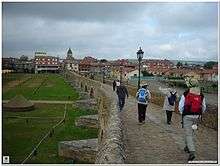Pas d'armes
The pas d'armes (French pronunciation: [pa daʁm]) or passage of arms was a type of chivalric hastilude that evolved in the late 14th century and remained popular through the 15th century. It involved a knight or group of knights (tenans or "holders") who would stake out a traveled spot, such as a bridge or city gate, and let it be known that any other knight who wished to pass (venans or "comers") must first fight, or be disgraced. If a traveling venan did not have weapons or horse to meet the challenge, one might be provided, and if the venan chose not to fight, he would leave his spurs behind as a sign of humiliation. If a lady passed unescorted, she would leave behind a glove or scarf, to be rescued and returned to her by a future knight who passed that way.

The origins of pas d'armes can be found in a number of factors. During the 14th and 15th centuries the chivalric idea of a noble knight clashed with new more deadly forms of warfare, as seen during the Hundred Years' War, when peasants armed with longbows could damage and wound knights anonymously from a distance, breaking traditional rules of chivalry; and cavalry charges could be broken by pikemen formations introduced by the Swiss.
At the same time, the noble classes began to differentiate themselves, in many ways, including through reading courtly literature such as the very popular chivalric romances of the 12th century. For the noble classes the line between reality and fiction blurred, the deeds they read about were real, while their deeds in reality were often deadly, if not comical, re-enactments of those they read about. This romanticised "Chivalric Revival" manifested itself in a number of ways, including the pas d'armes, round table and emprise (or empresa, enterprise, chivalrous adventure), and in increasingly elaborated rules of courtesy and heraldry.
There are many thousands of accounts of pas d'armes during this period. One notable and special account is that of Suero de Quiñones who in 1433 established the Passo Honroso ("Pass[age] of Honour") at the Órbigo bridge in Castile. This road was used by pilgrims all over Europe on the way to shrine at Santiago de Compostela and it was June when thousands would pass. Suero and ten knights promised to fight 300 times ("break 300 lances") before leaving the pas d'armes.
He and his men fought for over a month, an account of which is left to us in great detail by town notary Don Luis Alonso Luengo, who kept a detailed first-hand chronicle (latter published as Libro del Passo honroso[1]). After 166 battles Suero and his men were so injured they could not continue and declared the mission complete. Suero de Quiñones became legendary in Spanish history and was mentioned in Don Quixote, the 1605 satire on the sort of romantic chivalry out of touch with reality.
List of pas d'armes
- Passo de la Fuerte Ventura (1428)
- Pas de l'Arbre Charlemagne (Dijon, 1443)
- Pas de l'Arbre d'Or (Bruges, 1468)
- Pas de la Belle Pèlerine (Saint-Omer, 1449)
- Pas de la Bergère (1449)
- Pas du Chevalier au Cygne (1454)
- Pas de la Dame Inconnue (1463)
- Pas de la Dame Sauvage (Ghent, 1470)
- Pas de la Fontaine aux Pleurs (Chalon-sur-Saône, 1449-1450)
- Passo de la Fuerte Ventura (1428)
- Passo Honroso (1434)
- Pas de la Joyeuse Garde (1446)
- Pas de Nancy (Nancy, 1445)[2][3][4]
- Pas de la Pastourelle (around 1445)[5]
- Pas du Perron Feé (Bruges, 1463)
- Pas du Pin aux Pommes d'Or (1455)
- Pas de la Rocher Périlleux (1445)
See also
References
- ↑ Pedro Rodríguez de Lena (1930), A Critical Annotated Edition of El Passo Honroso de Suero de Quiñones, 1977 edition ISBN 84-7392-010-4
- ↑ Sylvie Lefèvre, Antoine de la Sale, Droz, 2006, p. 264.
- ↑ François Louis de Villeneuve, Histoire de René d'Anjou, tome premier, 1408-1445, Blaise, Paris, 1825, p. 354.
- ↑ Gabriel Bianciotto, Le roman de Troyle, université de Rouen, 1994, p. 147.
- ↑ Le luxe, le vêtement et la mode a la fin du Moyen-Age (French)
- Odile Blanc, Les stratégies de la parure dans le divertissement chevaleresque. In: Communications, 46, 1987. Parure pudeur étiquette, sous la direction de Olivier Burgelin, Philippe Perrot et Marie-Thérèse Basse. pp. 49–65. doi:10.3406/comm.1987.1686.
- Sébastien Nadot, Joutes, emprises et pas d'armes en Bourgogne, Castille et France, 1428-1470, thèse de doctorat soutenue à l'EHESS Paris en avril 2009.
- Sébastien Nadot, Rompez les lances ! Chevaliers et tournois au Moyen Age, Editions autrement, Paris, 2010.
- Riquer, Martín de (1967). Caballeros andantes españoles. Madrid: Editorial Espasa-Calpe.
External links
- Brian R. Price (1996), What is Pas d'Armes?
- Academy of European Medieval Martial Arts (AEMMA), Toronto, Canada.